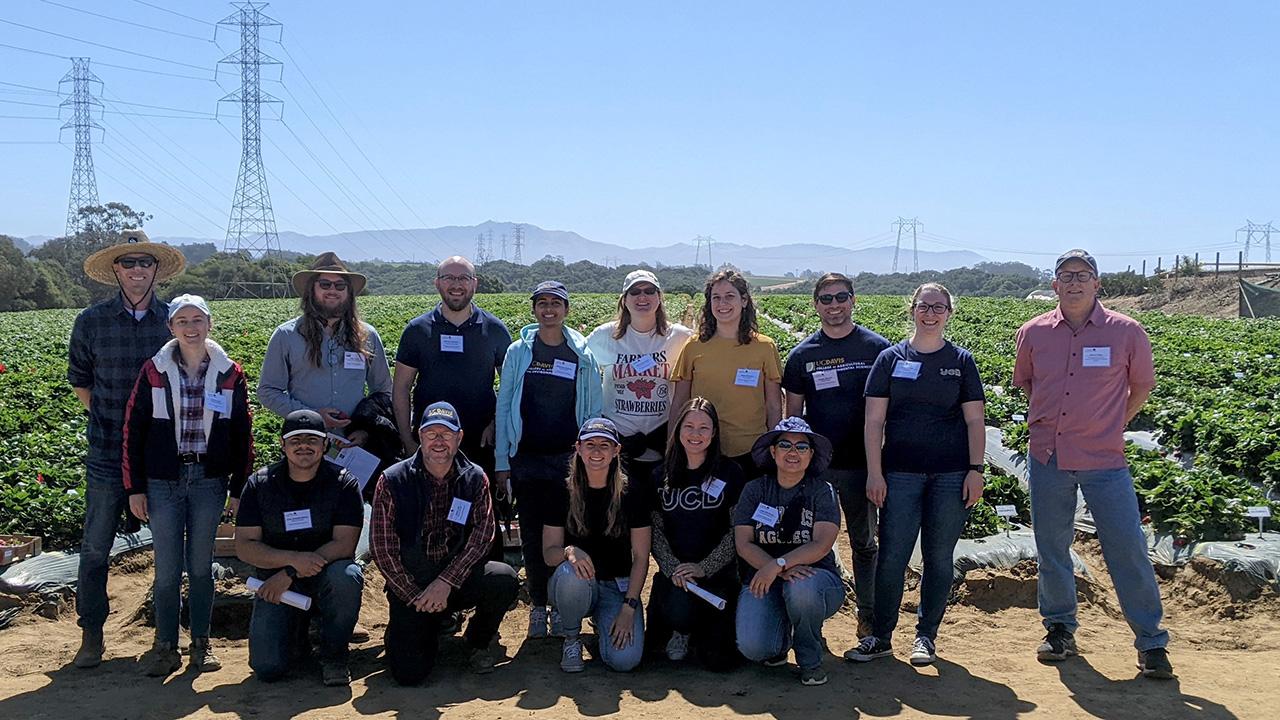
Feldmann named assistant professor
Aim: Breed strawberries to meet new challenges
Mitchell Feldmann has been hired as an assistant professor in the UC Davis Department of Plant Sciences and continues with the internationally prestigious UC Davis Strawberry Breeding Program. His assistant professor position began this month.
Feldmann has seven years of experience with the program, including as a doctoral student and postdoctoral researcher. The plan is for him to eventually take the helm of the Strawberry Breeding Program, now directed by Distinguished Professor Steve Knapp. The program’s mission is to provide strawberry growers with plants that resist pests and disease, grow efficiently and taste delicious.
In California, strawberries were valued at more than $3 billion in 2021, according to the state Department of Food and Agriculture, and the sector employs tens of thousands of people. But producing the popular berry is becoming more challenging, as growers face declining quality of irrigation water, increasing variability of climate, and diseases caused by new and existing threats; plus, rising costs of both land and labor.
“These are the challenges we are always going to have,” Feldmann said. He plans to build on the program’s successes in the past decade, speeding up the science to more quickly discover, produce and make available new varieties that can champion those challenges. And, he wants to make sure growers continue to trust those varieties.
“In so much of plant breeding, the quality of the product is essential, but the relationships you have with the people buying the plants and the seed, that’s just as important,” Feldmann said.
Ramping up the science in lab and field

Feldmann’s earliest experience with the program came when he was 8 years old and his family moved to Ventura County, among the state’s most productive berry-growing regions. “We had a guy down the road who sold the best strawberries, and they were UC Davis strawberries,” Feldmann recalled. He eventually earned a degree that focused on the genetic relationships between thale cress and turnip leafminer, a fly. His doctoral studies started with Knapp in 2015, using quantitative genetics to find the genes controlling fruit flavor, yield and shelf life.
As an assistant professor, Feldmann is looking for ways to reduce the time and cost of developing new varieties with qualities that meet the emerging needs of farmers, distributors and consumers. “How do we learn about plants in a way that saves us labor and time?” Feldmann posed. “There’s a lot of excellent science out there. I want to deploy this at a scale that’s suitable for a breeding program and adapts crops for the future and creates change.”
One avenue for success is using high throughput phenotyping — a set of techniques and technologies that measures the qualities he’s looking for, such as yield, acidity, sweetness, growth rate and disease resistance. “Breeding is a numbers game,” Feldmann said. “The more plant varieties you’re able to assess, the better decisions you can make.
In the field, ramping up the science means using more sensors, cameras, robots, drones and other technology that can stand in for manually measuring how candidate plants perform. “In science, most of our costs are associated with people,” Feldmann said. “Having them turn data into discoveries is much more valuable than having them in the field for days on end collecting data.”
Problem-solving with “moon-shot” ideas

Looking ahead, Feldmann is excited about developing strawberries with an architecture that would allow harvesting by machine — one way to deal with a labor force that is growing older, scarcer and more costly.
As coastal aquifers are drawn down and water becomes more saline, the program can seek “varieties that take up salts and get rid of them without affecting their productivity,” Feldmann added.
Deeper into the genetics, Feldmann wants to explore the role of meristems – cells that live in the growing tips of shoots and roots that can become different types of organs. Perhaps they could be fine-tuned to prevent the growth of runners under some conditions. “When strawberry plants produce runners, they become a weedy mess, and carbon is taken away from fruit production,” Feldmann explained. “Growers spend thousands of dollars an acre trimming runners, not once, but many times in the season….
“Strawberries have a lot of really cool problems to solve,” Feldmann added with a laugh. “It’s job security for a young breeder.”
Strawberries as art
The Strawberry Breeding Program has produced more than 70 varieties in nearly 100 years of operation. It is focused on the industry in California, which grows about 90 percent of strawberries consumed in the United States. But UC Davis strawberries also are grown by farmers around the world, with the help of research partners who conduct field trials in Mexico, Europe, North Africa and Australia.
While he’s conscious of the bottom line, Feldmann sees more in this luscious little mouthful bursting with juicy flavor. He noted strawberries are a luxury, not a staple like wheat, rice or corn, yet still somehow essential, valued by cultures around the world. “Life without art, is it life?” he said. “Life without fruit that we can enjoy is hard to imagine.”
About the UC Davis Strawberry Breeding Program
- 71 years at UC Davis — Since 1952
- 30+ patented varieties released
- 1,700 strawberry breeding plants in the germplasm collection
About California strawberries
- No. 5 — Fifth-largest crop in California in 2021
- $3.02 billion — Value of California’s strawberry crop in 2021
- 35,000 — Acres in California devoted to strawberry cultivation
- Strawberries are now a year-round crop
Editor's note: This article was updated 3/13/23 to clarify Feldmann’s role in the department.
Media Resources
- Trina Kleist, UC Davis Department of Plant Sciences, tkleist@ucdavis.edu, (530) 601-6846
